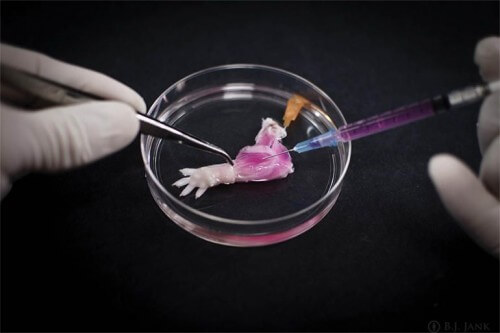Hope for amputees: scientists from the USA have succeeded in growing mammalian forelimbs in the laboratory from autologous stem cells, so the matching problem has been avoided.

Scientists have succeeded in producing the first biological hand in the laboratory!
Scientists from the USA, including researchers from leading hospitals in Massachusetts and Harvard University Medical School, succeeded in producing in the laboratory a forelimb of a rat and later also a hand of a monkey. In a groundbreaking study, the researchers overcame many technical obstacles on their way to the production of an initial prototype of a biological hand produced under laboratory conditions. This is important news in the field of limb transplants. Although there has been incredible progress in recent years with elaborate prostheses that can be operated with the power of thought, but it is still not about limbs that function and look like the real thing. Transplantation of limbs from other people is also something that has already been done, but there are many complications and difficulties associated with the rejection of foreign tissues.
In the current study, the researchers used a method that is already used to create relatively simple organs such as the heart, lungs and kidneys. The idea is to first take an organ or tissue from a dead animal, clean it of all soft tissues and leave only the collagenous skeleton, a rigid basic structure of the tissue. In the case of the arm, it is collagen fibers that build the bone, muscles and blood vessels. In the second stage, the tissue begins to be rebuilt by transplanting living cells from the animal in which the tissue will be transplanted.
Since the cells come from the transplanted person, an immune response of tissue rejection is not expected, which is one of the biggest problems in tissue transplantation. The construction of the arm is very complex and was done in stages when initially they implanted endothelial cells that build the inner layers of the blood vessels and then implanted cells that differentiate into muscle cells, and finally add cells that differentiate into skin cells. At the end of the process, the scientists showed that the new muscles have the ability to contract. Later, using a similar protocol, the scientists were able to reconstruct a monkey's hand.
It is important to understand, this is definitely an initial step and the road to creating functional limbs that can be implanted in amputees is still very long. The main obstacle is to build a hand or a leg that functions in terms of blood flow and neurologically. In any case, this is a research direction that gives hope to amputees that one day it will be possible to restore and revive their missing limbs.
The full scientific article

2 תגובות
Sounds like it's very far from a breakthrough.
The real wisdom is to use the natural mechanisms for differentiation and structure.
The level of complexity and functionality that can be achieved with the "manual" construction of organs is very limited.
There is no doubt at all that we live in an amazing time.